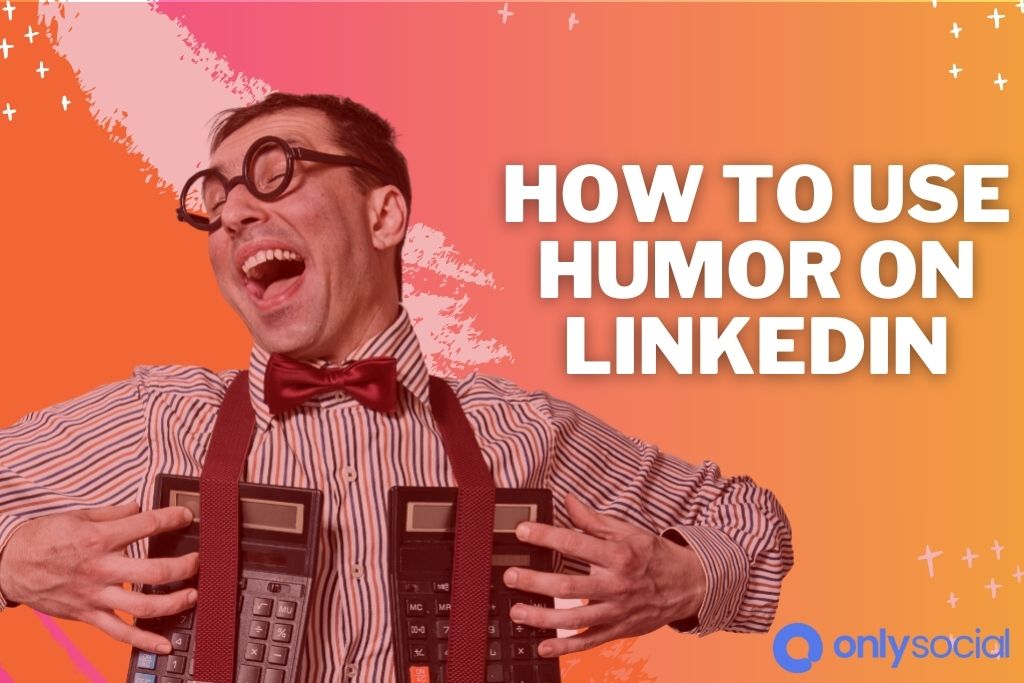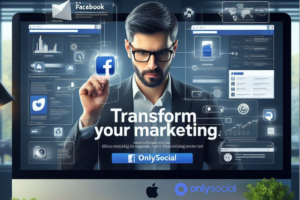Laughing Together: The Power of Humor on LinkedIn
Laughter truly knows no boundaries. It has the incredible ability to bridge gaps and create meaningful connections.
In the world of professionals, where LinkedIn takes center stage as a platform for networking and advancing careers, one might think that humor has no place.
Surprisingly, this article will delve into the advantages and techniques of incorporating humor on LinkedIn while maintaining professionalism.
By truly understanding your audience, crafting captivating updates, incorporating memes and GIFs, and strategically using humor across different LinkedIn features, you can effortlessly inject some lightheartedness into your profile without jeopardizing your credibility.
Table of Contents
- 1 The Benefits of Using Humor on LinkedIn
- 2 Understanding Your Audience on LinkedIn
- 3 Crafting Humorous LinkedIn Updates
- 4 Using Memes and GIFs to Add Humor on LinkedIn
- 5 Incorporating Humor in LinkedIn Articles and Posts
- 6 Leveraging Humor in LinkedIn Groups and Discussions
- 7 Avoiding Controversial Topics and Offensive Humor on LinkedIn
- 8 Maintaining Professionalism While Using Humor on Linkedin
- 9 BONUS
- 10 Frequently Asked Questions
- 10.1 Can I Use Humor on Linkedin for Personal Updates, or Should It Only Be Used for Professional Content?
- 10.2 How Can I Gauge the Sense of Humor of My Linkedin Connections Before Incorporating Humor Into My Updates?
- 10.3 Are There Any Guidelines or Best Practices for Using Memes and GIFs on Linkedin to Ensure They Are Appropriate and Professional?
- 10.4 Can Incorporating Humor in Linkedin Articles and Posts Help Improve Engagement and Reach?
- 10.5 How Can I Strike a Balance Between Being Humorous and Maintaining a Professional Image on Linkedin?
The Benefits of Using Humor on LinkedIn
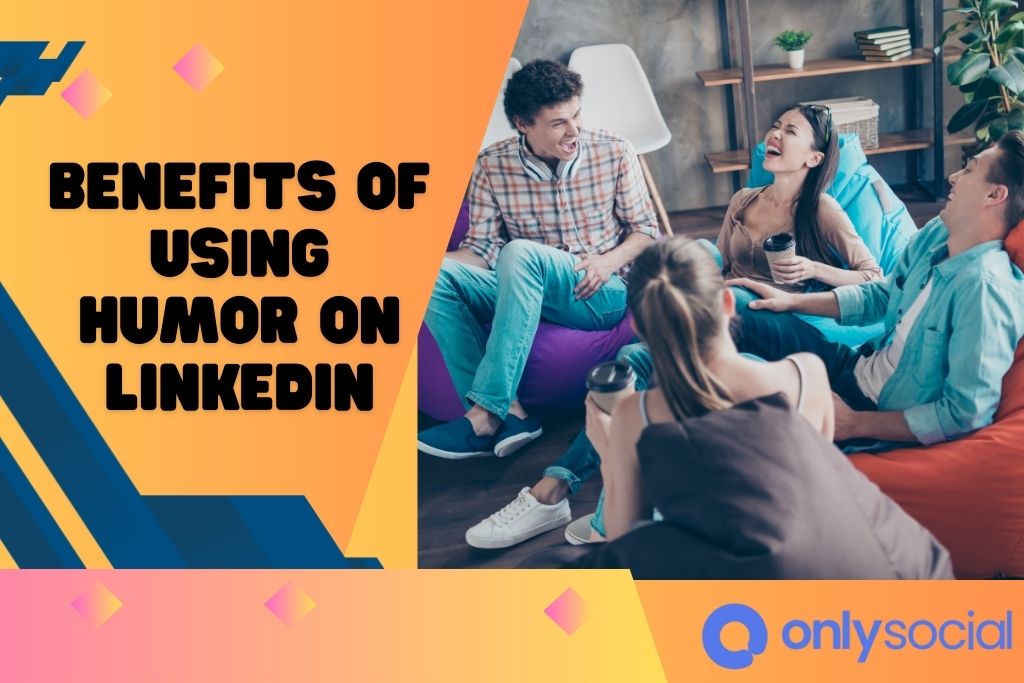
The benefits of incorporating humor on LinkedIn include increased engagement, improved brand perception, and enhanced networking opportunities.
Humor has been proven to be an effective tool for capturing the attention of online audiences and fostering a deeper connection with them. By using humor strategically in LinkedIn posts, individuals and businesses can make their content more relatable and enjoyable for their target audience.
One of the primary benefits of using humor on LinkedIn is increased engagement. Humorous posts tend to stand out in a sea of professional content, attracting more likes, comments, and shares from users. This increased engagement boosts post visibility and allows individuals and brands to reach a wider audience.
Furthermore, incorporating humor into LinkedIn content can improve brand perception. When done correctly, it showcases a lighter side to the individual or company behind the profile, making them appear more approachable and human. This can help build trust with the audience and enhance their perception of the brand’s authenticity.
Finally, utilizing humor on LinkedIn offers enhanced networking opportunities. By making people laugh or smile through humorous content, individuals increase their chances of being noticed by industry peers or potential employers. It creates an opportunity for organic conversations and fosters connections that may lead to new professional relationships or collaborations.
Understanding Your Audience on LinkedIn
This discussion focuses on two key points: targeting professional LinkedIn users and adapting humor for LinkedIn.
Understanding your LinkedIn audience to tailor your content and engage with them effectively is important.
Additionally, using humor on LinkedIn can be a powerful tool for building relationships and standing out, but it requires careful adaptation to maintain professionalism within the context of the platform.
Targeting Professional Linkedin Users
Targeting professional LinkedIn users can be achieved by tailoring humor to align with their industry and interests. Humor can be an effective tool for engaging a professional audience on LinkedIn, but it is important to strike the right balance between entertaining and maintaining professionalism. To effectively communicate with professional users, consider the following:
- Understand the industry: Research the target industry to identify common themes, challenges, and trends that can be incorporated into humorous content.
- Use relevant anecdotes: Share relatable stories or experiences that professionals in the industry can relate to and find amusing.
- Be mindful of tone: Maintain a respectful tone while injecting humor into your posts. Avoid offensive or controversial jokes that may alienate your audience.
- Incorporate visuals: Visuals such as memes or infographics can enhance the humorous impact of your content and make it more shareable.
- Test and analyze: Monitor engagement metrics such as likes, shares, and comments to gauge the effectiveness of your humor strategy.
Adapting Humor for Linkedin
Adapting humorous content for a professional audience on LinkedIn requires careful consideration of industry-specific themes, relatable anecdotes, respectful tone, visual elements, and continuous monitoring of engagement metrics. Humor can be an effective tool for networking on LinkedIn as it helps to create a positive and memorable impression. However, it is important to adapt humor appropriately to maintain professionalism. When using humor in job interviews or networking, it is crucial to ensure the jokes are relevant to the industry or profession being discussed. Additionally, incorporating relatable anecdotes can help establish a connection with the audience. A respectful tone should always be maintained to avoid offending anyone. Visual elements like memes or gifs can add an extra layer of humor when used appropriately. Continuous monitoring of engagement metrics allows you to gauge the audience’s response and adjust your approach accordingly.
| Pros | Cons |
|---|---|
| – Creates a positive impression | – Risk of offending someone |
| – Establishes a connection with the audience | – Inappropriate use may harm the professional reputation |
| – Adds an extra layer of humor | – Humor may overshadow key messages |
| – Enhances engagement and memorability | – Not everyone appreciates or understands humor |
Crafting Humorous LinkedIn Updates
Crafting humorous LinkedIn updates requires carefully balancing professionalism and incorporating lighthearted elements. It is important to remember that LinkedIn is primarily a professional networking platform, and humor should be used strategically to enhance engagement and convey personality without compromising one’s professional image.
To craft engaging content on LinkedIn while using storytelling techniques, consider the following:
- Authenticity: Share genuine stories or experiences related to your industry or expertise. This allows your audience to connect with you on a personal level.
- Relevance: Tailor your humor to your industry’s interests, challenges, or trends. This demonstrates your knowledge and understanding of the field.
- Tone: Use a conversational yet respectful tone when incorporating humor. Avoid controversial topics or offensive jokes that may alienate potential connections.
- Visual elements: Utilize images, GIFs, or videos that complement your humorous message. Visual content can help capture attention and make your updates more memorable.
- Timing: Consider posting humorous updates during appropriate holidays or industry events. This can help create a sense of community and camaraderie among professionals.
Using Memes and GIFs to Add Humor on LinkedIn
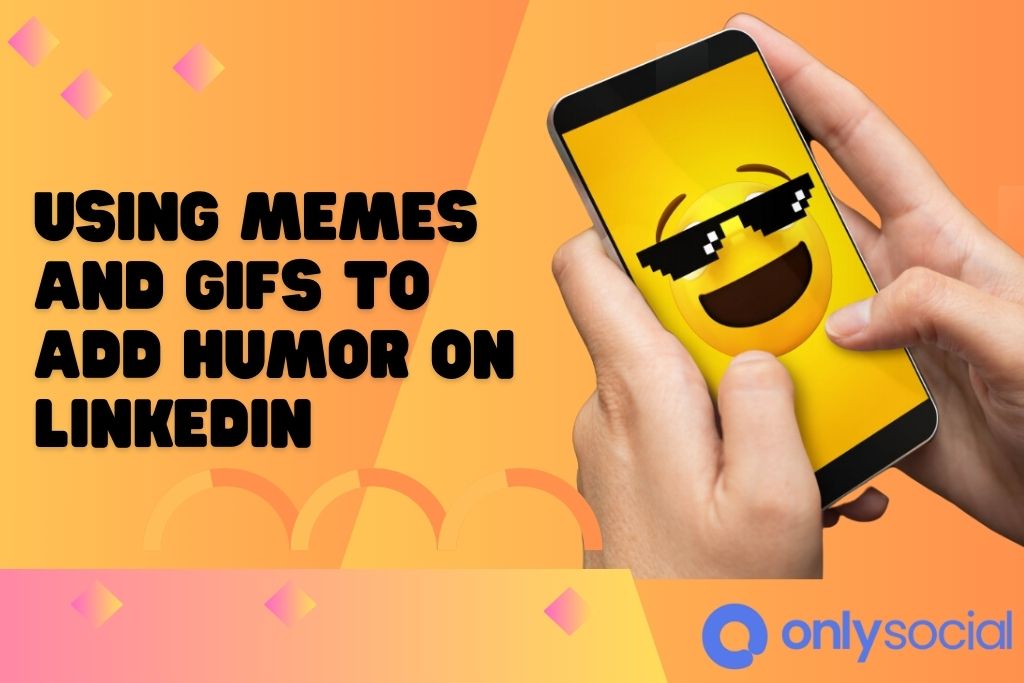
This discussion will explore the use of memes and GIFs as a means to add humor on LinkedIn. It will compare the effectiveness and appropriateness of using memes versus GIFs in professional contexts.
Additionally, it will address the challenge of balancing professionalism and humor when incorporating these visual elements into LinkedIn updates.
Memes Versus Gifs
When utilizing humor professionally, the distinction between memes and gifs on LinkedIn is important. While memes and gifs can be effective tools for engaging with audiences, they differ in format and impact. Here are five key differences between memes and gifs on LinkedIn:
- Memes are typically static images or text accompanied by a humorous caption, while gifs are short animated clips.
- Memes often rely on cultural references or inside jokes, which may limit their appeal to a specific audience.
- Conversely, GIFs can convey emotions and reactions more vividly due to their animated nature.
- Memes are more versatile in content creation, as they can be easily customized or created from scratch.
- GIFs provide a quick and visually engaging way to express ideas or reactions without relying heavily on text.
Understanding these distinctions will help professionals choose the most appropriate form of humor for their LinkedIn posts while considering the impact it may have on audience engagement.
Balancing Professionalism and Humor
Balancing professionalism with the incorporation of humor in written communication requires a thoughtful approach that considers the potential impact on audience engagement. Finding the right balance between being professional and injecting humor can be challenging, as it involves managing audience expectations.
While humor can make content more relatable and entertaining, it is important to ensure that it aligns with the overall tone and purpose of the message. Humor should not compromise professionalism or offend any members of the audience.
To manage audience expectations, it is crucial to understand their preferences and cultural sensitivities. By conducting thorough research and testing different approaches, writers can gauge the appropriateness of humor in their written communication.
Ultimately, carefully considering audience engagement and maintaining a professional tone will help balance professionalism and humor effectively.
Incorporating Humor in LinkedIn Articles and Posts
There are several effective ways to incorporate humor in LinkedIn articles and posts. One approach is to use relatable and lighthearted stories. Sharing funny experiences related to professional life can make content more engaging and relatable for the audience. Another way to incorporate humor is through visual humor. This can be done by incorporating memes, GIFs, or humorous images, which can add fun to posts and articles. Using puns or wordplay can also demonstrate creativity while adding a touch of humor. Cleverly using puns or wordplay can make content more enjoyable for readers. Another approach is to play with irony or sarcasm. Injecting subtle irony or sarcasm into content can intrigue and interest readers. However, it is crucial to keep the humor appropriate. Ensuring that humor aligns with professional standards and does not offend individuals or groups is important. By skillfully integrating humor into LinkedIn articles and posts, professionals can create a positive impression, foster engagement, and differentiate themselves from others in their network. Remember that striking the right balance between professionalism and humor is key to successfully utilizing this approach on LinkedIn.
Leveraging Humor in LinkedIn Groups and Discussions
Leveraging humor in LinkedIn groups and discussions can enrich conversation dynamics and foster a more engaging and interactive online community. While LinkedIn is primarily a professional networking platform, incorporating humor strategically can have several benefits. Humor can help break the ice, create a positive atmosphere, and make conversations more memorable. However, it is important to balance being funny and maintaining professionalism.
Using humor in job search-related LinkedIn groups or discussions requires careful consideration of the audience and context. It should be relevant to the discussed topic and avoid offensive or controversial content. Humor highlighting common challenges or experiences in the job search process can resonate well with individuals seeking employment.
Below is an example of how humor can be effectively leveraged in a LinkedIn group discussion about job interview experiences:
| Column 1 | Column 2 | Column 3 |
|---|---|---|
| Topic | Job Interview Experience | |
| Serious Comment | “I prepared extensively for my interview but tripped over my words! It was quite embarrassing.” | |
| Humorous Comment | “Interviewer: ‘Tell me about yourself.’ Me: ‘Well, I’m pretty good at pretending I know what I’m doing.'” |
Avoiding Controversial Topics and Offensive Humor on LinkedIn
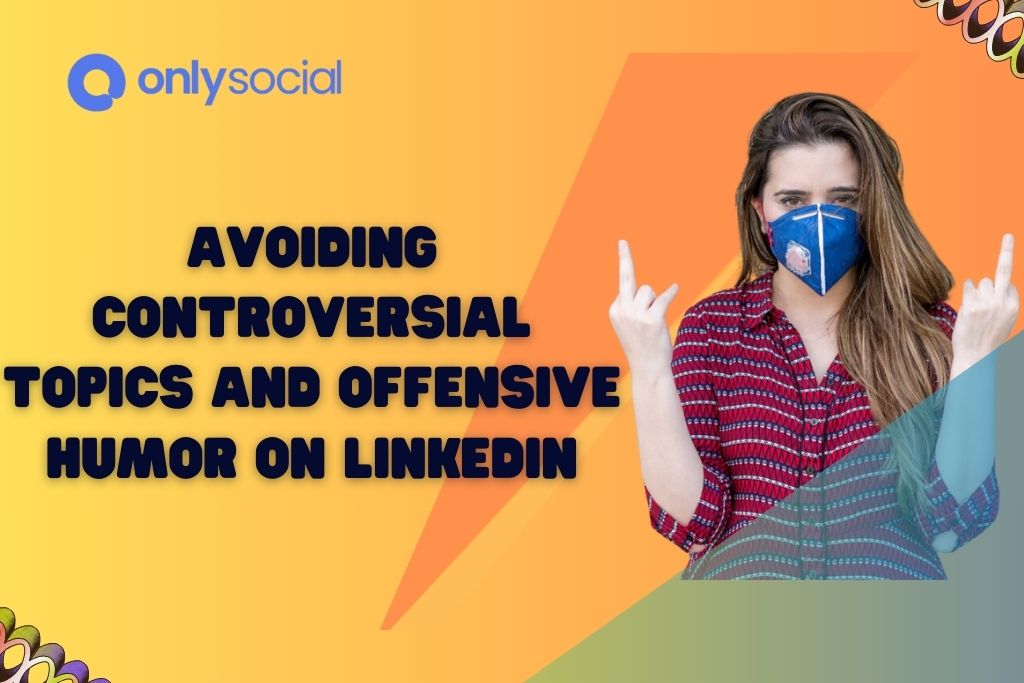
Avoiding controversial topics and offensive content is essential in maintaining a respectful and inclusive atmosphere within LinkedIn groups and discussions. LinkedIn is a professional networking platform where individuals connect with colleagues, potential employers, and industry leaders. Using humor appropriately can enhance engagement and build relationships, but it is important to navigate this terrain carefully.
To maintain professionalism while incorporating humor on LinkedIn, it is imperative to follow certain guidelines:
- Be mindful of cultural sensitivities: Humor should be universal and not rely on stereotypes or offend specific cultural or ethnic groups.
- Avoid divisive subjects: Topics such as politics, religion, or sensitive social issues can polarize opinions and detract from the intended purpose of professional networking.
- Respect differing perspectives: Ensure your humorous content does not belittle or mock others’ views or experiences.
- Keep it lighthearted: Use humor that is lighthearted, positive, and relevant to the context of the discussion.
- Consider your audience: Tailor your humor to suit the preferences of your LinkedIn connections, who may come from diverse professional backgrounds.
Maintaining Professionalism While Using Humor on Linkedin
Maintaining professionalism while incorporating humor on LinkedIn is crucial for establishing a positive and engaging environment conducive to professional networking. While humor can help showcase your personality and make you stand out, it is important to strike the right balance to maintain credibility and avoid being unprofessional or inappropriate.
One way to incorporate humor on LinkedIn is through job applications. A well-placed joke or witty remark can grab the attention of potential employers and leave a lasting impression. However, ensuring that the humor aligns with the tone of the industry or company you are applying to is essential. What may be funny in one context could be perceived as offensive or distasteful in another.
Another effective way to use humor on LinkedIn is by incorporating it into your profile. This can help humanize your online presence and make you more relatable to others in your professional network. For example, using a clever headline or adding a lighthearted anecdote in your summary section can show off your personality while maintaining professionalism.
| Incorporating Humor in Job Applications | Incorporating Humor in LinkedIn Profiles |
|---|---|
| Tailor jokes based on industry/context | Use clever headlines |
| Avoid offensive or distasteful humor | Add lighthearted anecdotes |
| Maintain professionalism | Showcase personality |
BONUS
Inject humor into your professional LinkedIn presence with OnlySocial’s Post Planning and Scheduling function. Planning and scheduling your posts across all social networks is crucial for combining humor and professionalism. OnlySocial offers unlimited posting and the ability to manage unlimited social profiles, enabling you to strike the perfect balance. Don’t miss out on this opportunity! Sign up for our commitment-free 7-day trial today.
Frequently Asked Questions
Can I Use Humor on Linkedin for Personal Updates, or Should It Only Be Used for Professional Content?
The use of humor in job applications and LinkedIn profiles is a topic of debate. While some argue it can add personality and make one stand out, others believe it may undermine professionalism and credibility.
How Can I Gauge the Sense of Humor of My Linkedin Connections Before Incorporating Humor Into My Updates?
Gauging humor compatibility among LinkedIn connections is crucial when incorporating humor in networking. This can be achieved by observing their online presence, engaging in casual conversations, and gradually introducing lighthearted content to maintain professionalism.
Are There Any Guidelines or Best Practices for Using Memes and GIFs on Linkedin to Ensure They Are Appropriate and Professional?
Appropriate guidelines for using memes and gifs on LinkedIn while maintaining professionalism can be beneficial. Ensuring the content is relevant, non-offensive, and aligns with professional values can help create a positive impression and engage the audience effectively.
Can Incorporating Humor in Linkedin Articles and Posts Help Improve Engagement and Reach?
Incorporating humor in LinkedIn articles and posts can potentially improve engagement and reach by attracting attention, creating a positive impression, and fostering relatability with the audience.
How Can I Strike a Balance Between Being Humorous and Maintaining a Professional Image on Linkedin?
Striking the right balance between humor and professionalism on LinkedIn can be challenging. Leveraging wit to enhance engagement and impact of professional profiles and crafting comedic content without compromising credibility are two potential strategies to explore.

